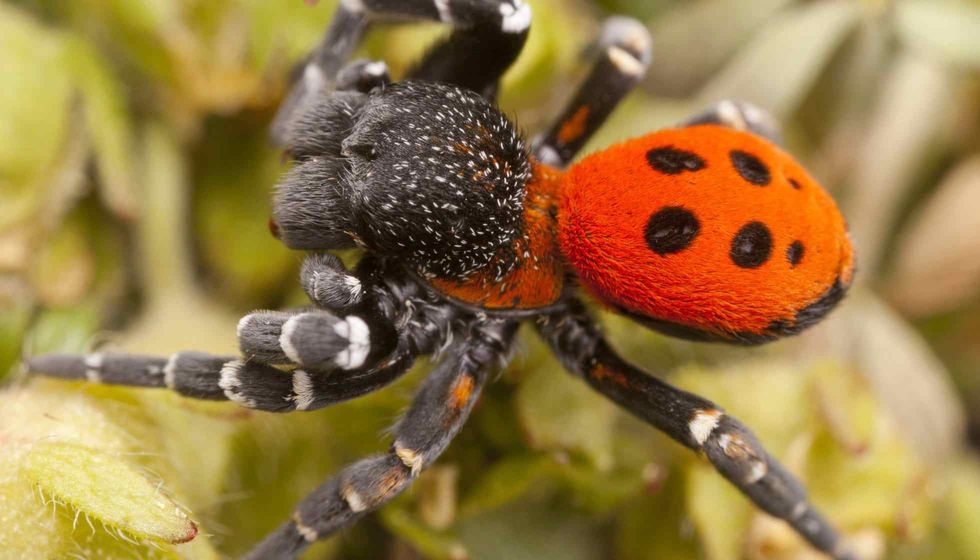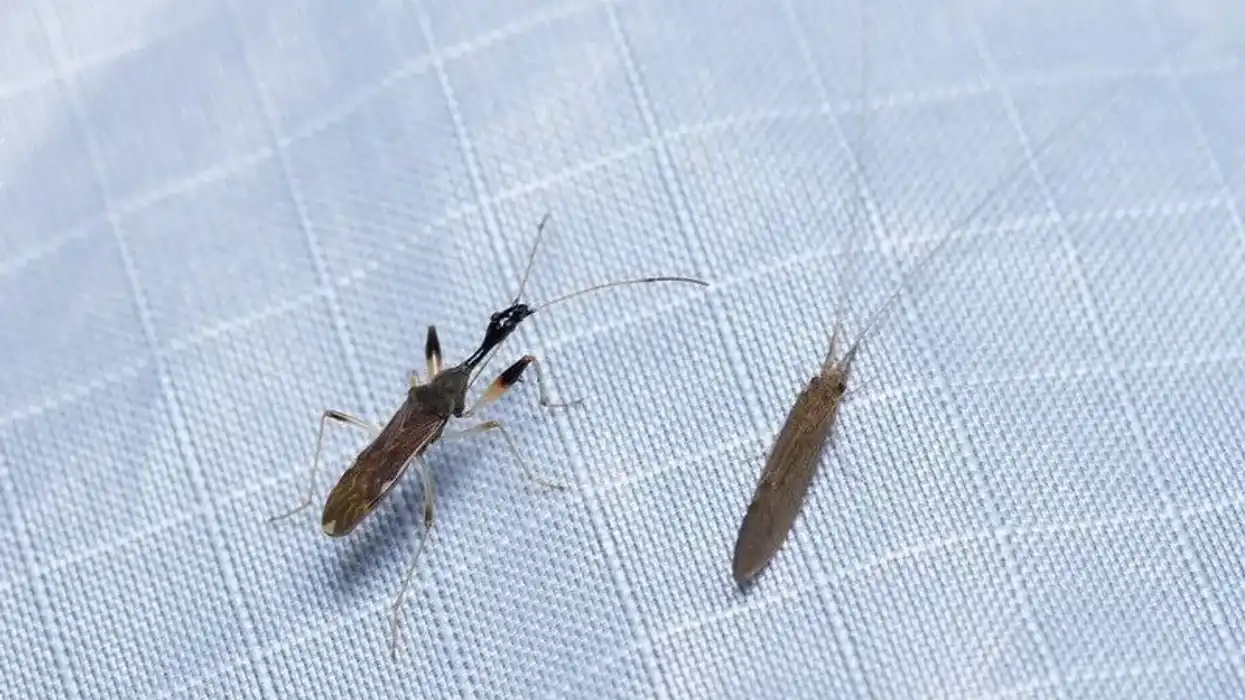Ladybird spiders are spiders with a stunning appearance, described by Charles Athanase Walckenaer for the first time in 1805. They are endangered spiders that face the risk of extinction in the UK.
They have been saved from possible extinction in parts of England by constant conservation efforts of the U.K. Biodiversity Action Plan. They are members of the Erisidae family, whose members are commonly known as velvet spider/ladybird spider.
Immature males and females are black mainly, with males developing a striking red abdomen possessing black spots. There are four black dots that are arranged in a dice-like pattern.
Their magnificent pattern is also believed to be a warning to predators. These spiders are called ladybird spiders due to their appearance which is similar to that of a ladybird beetle who also has black spots over its red body.
Ladybird spiders are not related to ladybirds in any way. These rare spiders occur in some regions of central Europe and Greenland.
This adorable creature is known to inhabit lowland heathland, where it builds silk-lined, vertical burrows that possess a silk canopy on top to attack its prey! Keep reading to get to know more fascinating facts about these spiders!
If you enjoyed reading our cool facts about the ladybird spider, you must check out our garden orb weaver surprising facts and green lynx spider fun facts!
Ladybird Spider Interesting Facts
What type of animal is a ladybird spider?
They are spiders that belong to the Eresus genus which comprises various species of velvet spiders, like, Eresus sandaliatus and Eresus cinnaberinus. These spiders were assumed to be extinct but were rediscovered in 1980 on a Dorset heathland, in the UK. These spiders mainly occur in Northern and Eastern Europe.
What class of animal does a ladybird spider belong to?
Like all spiders, such as the rain spider and the wolf spider, the ladybird spider also belongs to the class Arachnida.
How many ladybird spiders are there in the world?
These spiders are rare and are one of the most endangered species in the UK. In the UK, there are about 14 populations, comprising 1000 spiders approximately.
Where does a ladybird spider live?
This brightly colored creature can be found inhabiting lowland heathland, where it builds vertical, silk-lined burrows that possess a silk canopy on top to attack its prey. Heathland is a perfect place for them to inhabit.
They can be found in Central, Northern, and Eastern Europe, and can be seen in some regions of the Alps and Pyrenees. In Germany, Denmark, Sweden, and the Netherlands, it is on the Red List. They can be seen in southwest England's Dorset county.
What is a ladybird spider's habitat?
Species of ladybird spiders favor sheltered sloped facing south that has well-drained sandy soil. They build their burrows amongst heather and stones. Their silk-lined burrows have a depth of 3.9 in (10 cm). Their webs are messy.
The soil of their home is often acidic and nutrient-poor. Females of this species live in the burrows their whole life whereas the males travel to mate with the females. They favor heathlands as a habitat as it is an open wide land with plants liked gorse, heathers, and grasses.
Who do ladybird spiders live with?
They live in colonies that do not travel for more than 32.8-39.3 ft (10-12 m). Afragmanted heathlands can seriously decline the population of this species as they live in tight colonies.
How long does a ladybird spider live?
Males achieve sexual maturity at the age of three years. They move out of their burrows to search and mate with a female. After mating, they die. The female attains sexual maturity at the age of four to five years and can live longer than the male if he hasn't discovered her.
How do they reproduce?
In late April or early May, males emerge from their underground homes and look for a mating partner. The female lays 35-50 eggs after mating in her burrow. The eggs are taken care of by her only.
The spiderlings that emerge are taken care of by the female in a nursery web. The mother dies a month after her eggs hatch. Spiderlings eat the female ladybird spider, their mother, before leaving home!
What is their conservation status?
These spiders aren't evaluated by the IUCN yet. However, they have been declared nationally rare and are listed as endangered by the British Red Data Book.
They have been pulled back from extinction in parts of England by constant conservation efforts of the U.K. Biodiversity Action Plan. These spiders depend upon their lowland heathland habitat, which is declining due to development, land-use changes, forestry, and agriculture.
They were considered to be extinct in Britain for 70 years, until 1980, when they were rediscovered in Dorset. Due to constant conservation efforts, there now exist 14 populations comprising 1000 individuals. Their populations grew to 19 when five populations were translocated to new habitat areas.
The populations across Dorset are monitored to conserve this species and help them thrive in their habitat. They have been receiving protection from the Wildlife and Countryside Act since 1981.
Ladybird Spider Fun Facts
What do ladybird spiders look like?
These spiders are named after ladybirds due to their dazzling red, spotted, body. They have four black-colored, big dots on their back that are arranged in the same way a dice!
It is believed that this pattern is a possible warning to predators. Male ladybird spiders are very small in size, almost the same as that on a ladybird. Females are larger slightly and are dark grey or velvet black.
Only adult males possess the stunning bright red body along with four black-colored spots. These ladybird spiders have hairy bodies and have six legs.
How cute are they?
These spiders look quite cute and not spooky like other spiders. They are quite festive looking, with their classic red and black coloration.
How do they communicate?
Spiders use vibrations of their webs to communicate!
How big is a ladybird spider?
The ladybird spider size is very small with the male ladybird spider ranging between 0.23-0.35 in (0.58-0.88 cm) and the female between 0.39-0.62 in (0.99-1.5 cm). They can reach the size of a ladybird!
How fast can ladybird spiders move?
These spiders have a weak potential to disperse. They don't travel large distances to build new burrows or to start a new colony. They remain in the vicinity of their burrows. They have been observed to stay in the range of 32.8-39.3 ft (10-12 m) from their burrows.
How much does a ladybird spider weigh?
The weight of these spiders has not been evaluated yet. However, considering their small size similar to that of a ladybird, they must weigh very little.
What are the male and female names of the species?
They do not have any distinct names based on their sex.
What would you call a baby ladybird spider?
A baby spider can be referred to as a spiderling.
What do they eat?
They are very small in size but can devour insects twice their size like beetles! Their predators are not known yet, but given their small size, it is believed that they are preyed upon by birds and lizards.
Is the ladybird spider poisonous?
No, it is not poisonous. It is known to bite when it feels threatened. However, the bite does not cause any serious effects.
Would they make a good pet?
These creatures are considered to be rare and it would be illegal to keep them as a pet.
Did you know...
The ladybird spider web has been observed to be decorated with the remains of their victims!
Types of ladybird spiders?
They are spiders that belong to the Eresus genus which comprises 21 species of these spiders, like, Eresus sandaliatus and Eresus cinnaberinus.
How rare are ladybird spiders?3
They are nationally rare and are listed as endangered by the British Red Data Book.
Here at Kidadl, we have carefully created lots of interesting family-friendly animal facts for everyone to discover! For more relatable content, check out these whip spider fun facts and the southern house spider surprising facts!
You can even occupy yourself at home by coloring in one of our free printable ladybird spider coloring pages.










